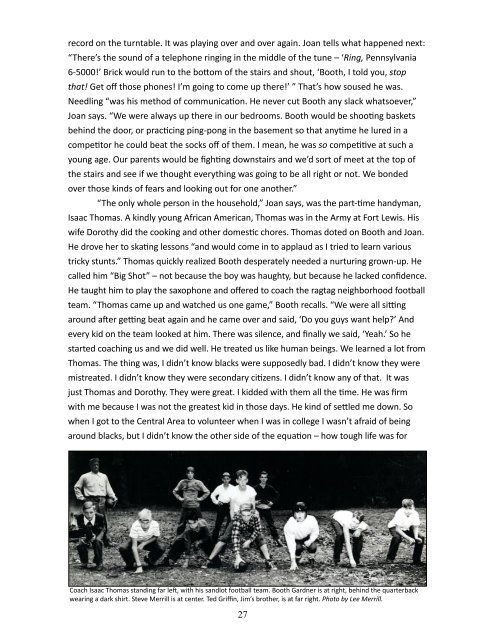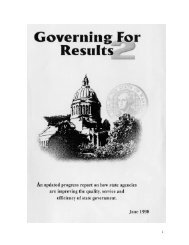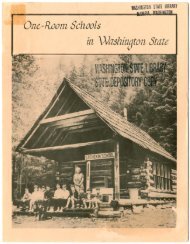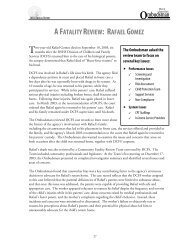BOOTH WHO? - Washington State Digital Archives
BOOTH WHO? - Washington State Digital Archives
BOOTH WHO? - Washington State Digital Archives
Create successful ePaper yourself
Turn your PDF publications into a flip-book with our unique Google optimized e-Paper software.
ecord on the turntable. It was playing over and over again. Joan tells what happened next:<br />
“There’s the sound of a telephone ringing in the middle of the tune – ‘Ring, Pennsylvania<br />
6-5000!’ Brick would run to the bottom of the stairs and shout, ‘Booth, I told you, stop<br />
that! Get off those phones! I’m going to come up there!’ ” That’s how soused he was.<br />
Needling “was his method of communication. He never cut Booth any slack whatsoever,”<br />
Joan says. “We were always up there in our bedrooms. Booth would be shooting baskets<br />
behind the door, or practicing ping-pong in the basement so that anytime he lured in a<br />
competitor he could beat the socks off of them. I mean, he was so competitive at such a<br />
young age. Our parents would be fighting downstairs and we’d sort of meet at the top of<br />
the stairs and see if we thought everything was going to be all right or not. We bonded<br />
over those kinds of fears and looking out for one another.”<br />
“The only whole person in the household,” Joan says, was the part-time handyman,<br />
Isaac Thomas. A kindly young African American, Thomas was in the Army at Fort Lewis. His<br />
wife Dorothy did the cooking and other domestic chores. Thomas doted on Booth and Joan.<br />
He drove her to skating lessons “and would come in to applaud as I tried to learn various<br />
tricky stunts.” Thomas quickly realized Booth desperately needed a nurturing grown-up. He<br />
called him “Big Shot” – not because the boy was haughty, but because he lacked confidence.<br />
He taught him to play the saxophone and offered to coach the ragtag neighborhood football<br />
team. “Thomas came up and watched us one game,” Booth recalls. “We were all sitting<br />
around after getting beat again and he came over and said, ‘Do you guys want help?’ And<br />
every kid on the team looked at him. There was silence, and finally we said, ‘Yeah.’ So he<br />
started coaching us and we did well. He treated us like human beings. We learned a lot from<br />
Thomas. The thing was, I didn’t know blacks were supposedly bad. I didn’t know they were<br />
mistreated. I didn’t know they were secondary citizens. I didn’t know any of that. It was<br />
just Thomas and Dorothy. They were great. I kidded with them all the time. He was firm<br />
with me because I was not the greatest kid in those days. He kind of settled me down. So<br />
when I got to the Central Area to volunteer when I was in college I wasn’t afraid of being<br />
around blacks, but I didn’t know the other side of the equation – how tough life was for<br />
Coach Isaac Thomas standing far left, with his sandlot football team. Booth Gardner is at right, behind the quarterback<br />
wearing a dark shirt. Steve Merrill is at center. Ted Griffin, Jim’s brother, is at far right. Photo by Lee Merrill.<br />
27
















